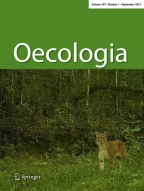Abstract
The acetylene reduction method was used to measure nitrogen fixation in the phyllosphere of attached leaves of different phorophytes under natural conditions in a premontane rain forest in Costa Rica. Maximum rates of nitrogen fixation (26 ng N · cm−2 leaf area · h−1) – mainly due to the activity of two species of Scytonema (Cyanobacteria) – were measured in the rainy season in bright sunlight. Rates of nitrogen fixation were correlated with the leaf area covered by Scytonema. In periods without precipitation the fixation activity decreased to zero within 2–3 days. As long as the epiphylls were sufficiently supplied with water, other microclimatic factors like temperature and light intensity also influenced nitrogen fixation rates, but to a lesser extent. Relative humidity and species of phorophyte showed no direct influence. It was concluded that the most important factor for nitrogen fixation in the phyllosphere was the availability of liquid water. Linking these results to meteorological data, the input of nitrogen by biological nitrogen fixation in the phyllosphere in the investigation area was estimated to be as much as 1.6 ± 0.8 kg N · ha−1 · year−1 per unit of leaf area index (LAI). For an LAI of 2 for the understory the nitrogen input would vary between 2 and 5 kg N · ha−1 · year−1. This work also demonstrates the importance of detailed knowledge of variation in microclimate throughout the year as a basis for extrapolation of the annual nitrogen input.
Similar content being viewed by others
Author information
Authors and Affiliations
Additional information
Received: 21 December 1997 / Accepted: 14 June 1998
Rights and permissions
About this article
Cite this article
Freiberg, E. Microclimatic parameters influencing nitrogen fixation in the phyllosphere in a Costa Rican premontane rain forest. Oecologia 117, 9–18 (1998). https://doi.org/10.1007/s004420050625
Issue Date:
DOI: https://doi.org/10.1007/s004420050625
